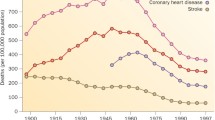Abstract
The term prehypertension, which first appeared in the Seventh Report of the Joint National Committee (JNC 7) in 2003, has sparked controversy in the field of hypertension. Systolic blood pressure (BP) rises with age in industrialized societies, but an individual’s rate of rise of systolic BP and the age at which BP crosses the arbitrary threshold of hypertension depends on prior BP levels (hence “prehypertension”). Obesity, another major factor in prehypertension, activates neurohumoral systems (renin-angiotensin and sympathetic nervous) and contributes to age-related BP increases. The JNC 7 recommendation for prehypertension management with optimal weight control (largely through diet and exercise) remains the mainstay, especially in the elderly. The Trial of Prevention of Hypertension demonstrated that angiotensin receptor blockade (ARB) retards age-related BP increases in prehypertensive patients. Associated elevated risk conditions (prediabetes, hypercholesterolemia, microalbuminuria) may justify early use of ARB therapy (in men and in women without childbearing potential) if weight control fails.
Similar content being viewed by others
References and Recommended Reading
Chobanian AV, Bakris GL, Black HR, et al.: The seventh report of the joint national committee on prevention, detection, evaluation, and treatment of high blood pressure: JNC 7 express. JAMA 2003, 289:2560–2572.
Burt VL, Whelton P, Roccella EJ, et al.: Prevalence of hypertension in the US adult population: results from the third national health and nutrition examination survey, 1988–1991. Hypertension 1995, 25:305–313.
Franklin SS, Gustin WT, Wong ND, et al.: Hemodynamic patterns of age-related changes in blood pressure. The Framingham Heart Study. Circulation 1997, 96:308–315.
Vasan RS, Beiser A, Seshadri S, et al.: Residual lifetime risk for developing hypertension in middle-aged women and men: the Framingham Heart Study. JAMA 2002, 287:1003–1010.
Hollenberg NK, Martinez G, McCullough M, et al.: Aging, acculturation, salt intake, and hypertension in the Kuna of Panama. Hypertension 1997, 29:171–176.
Izzo JL Jr, Levy D, Black HR: Clinical advisory statement: importance of systolic blood pressure in older Americans. Hypertension 2000, 35:1021–1024.
Lewington S, Clarke R, Qizilbash N, et al.: Age-specific relevance of usual blood pressure to vascular mortality: a meta-analysis of individual data for one million adults in 61 prospective studies. Lancet 2002, 360:1903–1913.
Franklin SS, Jacobs MJ, Wong ND, et al.: Predominance of isolated systolic hypertension among middle-aged and elderly US hypertensives: analysis based on National Health and Nutrition Examination Survey (NHANES) III. Hypertension 2001, 37:869–874.
Neaton JD, Wentworth D, Group MR: Serumcholesterol, blood pressure, cigarette smoking, and death from coronary heart disease: overall findings and differences by age for 316,099 white men. Arch Intern Med 1992, 152:56–64.
Benetos A, Zureik M, Morcet J, et al.: A decrease in diastolic blood pressure combined with an increase in systolic blood pressure is associated with a higher cardiovascular mortality in men. J Am Coll Cardiol 2000, 35:673–680.
Giles TD, Berk BC, Black HR, et al.: Expanding the definition and classification of hypertension. J Clin Hypertens 2005, 7:505–512.
Julius S, Nesbitt SD, Egan BM, et al.: Feasibility of treating prehypertension with an angiotensin-receptor blocker. N Engl J Med 2006, 354:1685–1697.
Julius S, Krause L, Schork NJ, et al.: Hyperkinetic borderline hypertension in Tecumseh, Michigan. J Hypertens 1991, 9:77–84.
Drukteinis JS, Roman MJ, Fabsitz RR, et al.: Cardiac and systemic hemodynamic characteristics of hypertension and prehypertension in adolescents and young adults: the Strong Heart Study. Circulation 2007, 115:221–227.
Sung BH, Wilson MF, Izzo JL Jr, et al.: Moderately obese, insulin-resistant women exhibit abnormal vascular reactivity to stress. Hypertension 1997, 30:848–853.
Sung BH, Izzo JL Jr, Wilson MF: Effects of cholesterol reduction on BP response to mental stress in patients with high cholesterol. Am J Hypertens 1997, 10: 592–599.
Messerli FH, Sundgaard-Riise K, Ventura HO, et al.: Essential hypertension in the elderly: haemodynamics, intravascular volume, plasm a renin activity, and circulating catecholamine levels. Lancet 1983, 2:983–986.
Izzo JL Jr, Smith RJ, Larrabee PS, Kallay MC: Plasma norepinephrine and age as determinants of systemic hemodynamics in men with established essential hypertension. Hypertension 1987, 9:415–419.
Mitchell GF, Lacourciere Y, Ouellet JP, et al.: Determinants of elevated pulse pressure in middle-aged and older subjects with uncomplicated systolic hypertension: the role of proximal aortic diameter and the aortic pressure-flow relationship. Circulation 2003, 108:1592–1598.
Svetkey LP, Erlinger TP, Vollmer WM, et al.: Effect of lifestyle modifications on blood pressure by race, sex, hypertension status, and age. J Hum Hypertens 2005, 19:21–31.
Straznicky NE, Lambert EA, Lambert GW, et al.: Effects of dietary weight loss on sympathetic activity and cardiac risk factors associated with the metabolic syndrome. J Clin Endocrinol Metab 2005, 90:5998–6005.
Haller H, Viberti GC, Mimran A, et al.: Preventing microalbuminuria in patients with diabetes: rationale and design of the Randomised Olmesartan and Diabetes Microalbuminuria Prevention (ROADMAP) Study. J Hypertens 2006, 24:403–408.
Author information
Authors and Affiliations
Corresponding author
Rights and permissions
About this article
Cite this article
Izzo, J.L. Prehypertension: Demographics, pathophysiology, and treatment. Current Science Inc 9, 264–268 (2007). https://doi.org/10.1007/s11906-007-0049-8
Published:
Issue Date:
DOI: https://doi.org/10.1007/s11906-007-0049-8




